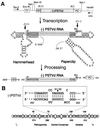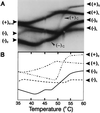Precisely full length, circularizable, complementary RNA: an infectious form of potato spindle tuber viroid
- PMID: 9601006
- PMCID: PMC27879
- DOI: 10.1073/pnas.95.11.6560
Precisely full length, circularizable, complementary RNA: an infectious form of potato spindle tuber viroid
Abstract
The replication of many viral and subviral pathogens as well as the amplification of certain cellular genes proceeds via a rolling circle mechanism. For potato spindle tuber (PSTVd) and related viroids, the possible role of a circular (-)strand RNA as a template for synthesis of (+)strand progeny is unclear. Infected plants appear to contain only multimeric linear (-)strand RNAs, and attempts to initiate infection with multimeric (-)PSTVd RNAs generally have failed. To examine critically the infectivity of monomeric (-)strand viroid RNAs, we have developed a ribozyme-based expression system for the production of precisely full length (-)strand RNAs whose termini are capable of undergoing facile circularization in vitro. Mechanical inoculation of tomato seedlings with electrophoretically purified (-)PSTVd RNA led to a small fraction of plants becoming infected whereas parallel assays with an analogous tomato planta macho viroid (-)RNA resulted in a much larger fraction of infected plants. Ribozyme-mediated production of (-)PSTVd RNA in transgenic plants led to the appearance of monomeric circular (-)PSTVd RNA and large amounts of (+)PSTVd progeny. No monomeric circular (-)PSTVd RNA could be detected in naturally infected plants by using either ribonuclease protection or electrophoresis under partially denaturing conditions. Although not a component of the normal replicative pathway, precisely full length (-)PSTVd RNA appears to contain all of the structural and regulatory elements necessary for initiation of viroid replication.
Figures






Similar articles
-
Tertiary structural and functional analyses of a viroid RNA motif by isostericity matrix and mutagenesis reveal its essential role in replication.J Virol. 2006 Sep;80(17):8566-81. doi: 10.1128/JVI.00837-06. J Virol. 2006. PMID: 16912306 Free PMC article.
-
Potato Spindle Tuber Viroid Modulates Its Replication through a Direct Interaction with a Splicing Regulator.J Virol. 2018 Sep 26;92(20):e01004-18. doi: 10.1128/JVI.01004-18. Print 2018 Oct 15. J Virol. 2018. PMID: 30068655 Free PMC article.
-
Ribozyme-mediated high resistance against potato spindle tuber viroid in transgenic potatoes.Proc Natl Acad Sci U S A. 1997 May 13;94(10):4861-5. doi: 10.1073/pnas.94.10.4861. Proc Natl Acad Sci U S A. 1997. PMID: 9144155 Free PMC article.
-
Potato Spindle Tuber Viroid RNA-Templated Transcription: Factors and Regulation.Viruses. 2018 Sep 17;10(9):503. doi: 10.3390/v10090503. Viruses. 2018. PMID: 30227597 Free PMC article. Review.
-
The discovery and eradication of potato spindle tuber viroid in Canada.Virusdisease. 2014 Dec;25(4):415-24. doi: 10.1007/s13337-014-0225-9. Epub 2014 Dec 2. Virusdisease. 2014. PMID: 25674616 Free PMC article. Review.
Cited by
-
Eggplant latent viroid, the candidate type species for a new genus within the family Avsunviroidae (hammerhead viroids).J Virol. 2003 Jun;77(11):6528-32. doi: 10.1128/jvi.77.11.6528-6532.2003. J Virol. 2003. PMID: 12743309 Free PMC article.
-
Dissecting the secondary structure of the circular RNA of a nuclear viroid in vivo: A "naked" rod-like conformation similar but not identical to that observed in vitro.RNA Biol. 2017 Aug 3;14(8):1046-1054. doi: 10.1080/15476286.2016.1223005. Epub 2016 Aug 30. RNA Biol. 2017. PMID: 27574720 Free PMC article.
-
Viroids: Non-Coding Circular RNAs Able to Autonomously Replicate and Infect Higher Plants.Biology (Basel). 2023 Jan 21;12(2):172. doi: 10.3390/biology12020172. Biology (Basel). 2023. PMID: 36829451 Free PMC article. Review.
-
Putative replication intermediates in endornavirus, a novel genus of plant dsRNA viruses.Virus Genes. 2004 Dec;29(3):365-75. doi: 10.1007/s11262-004-7441-0. Virus Genes. 2004. PMID: 15550778
-
Processing of nuclear viroids in vivo: an interplay between RNA conformations.PLoS Pathog. 2007 Nov;3(11):e182. doi: 10.1371/journal.ppat.0030182. PLoS Pathog. 2007. PMID: 18052530 Free PMC article.
References
-
- Diener T O, editor. The Viroids. New York: Plenum; 1987.
-
- Semancik J S, editor. Viroids and Viroid-Like Pathogens. Boca Raton, FL: CRC; 1987.
-
- Branch A D, Robertson H D. Science. 1984;223:450–455. - PubMed
Publication types
MeSH terms
Substances
LinkOut - more resources
Full Text Sources

